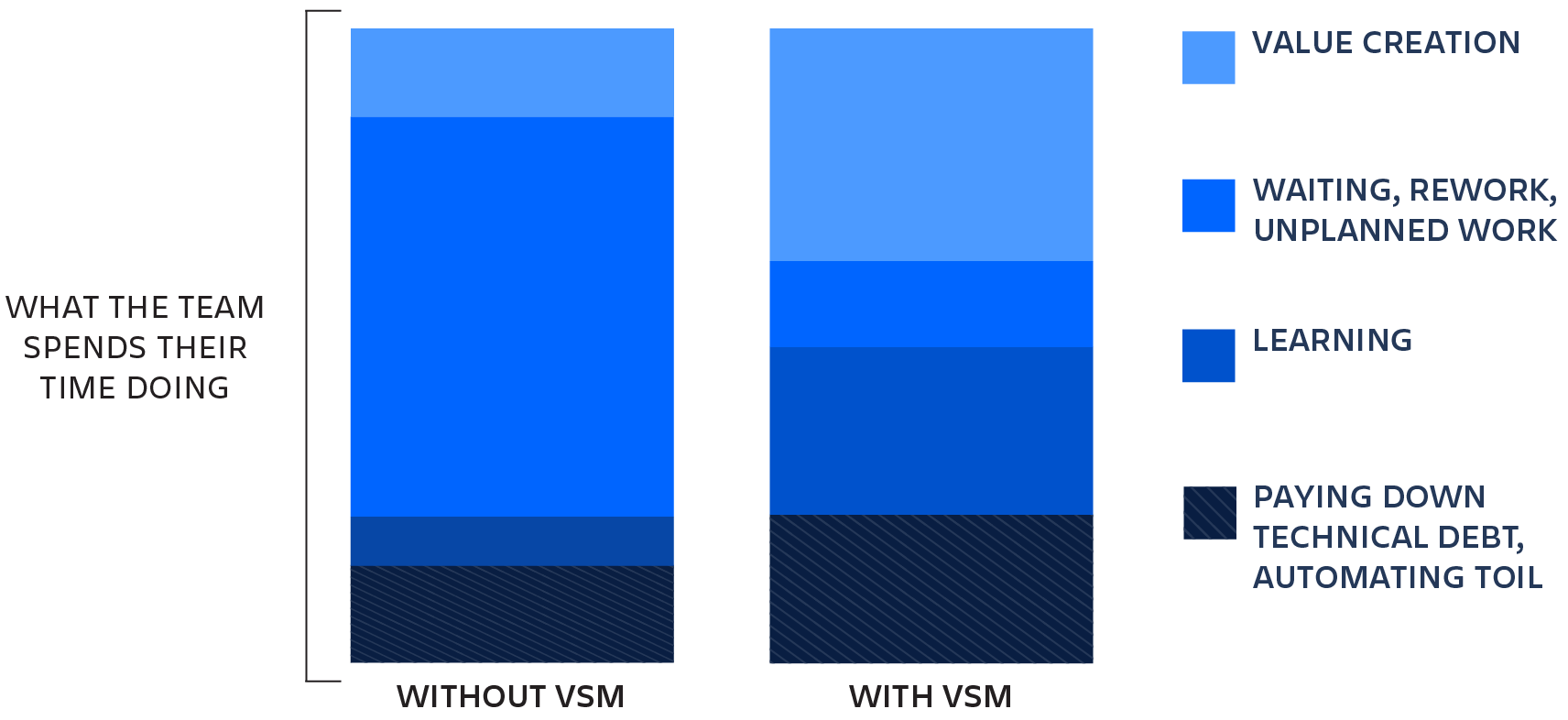Key Takeaways
Value stream management (VSM) optimizes the flow of value from idea to customer, improving delivery speed and quality.
VSM connects business strategy with Agile and DevOps teams, breaking down silos and aligning around customer outcomes.
Mapping value streams reveals bottlenecks, inefficiencies, and opportunities for improvement.
Implement VSM to increase predictability, customer satisfaction, and innovation across your organization.
バリュー ストリーム管理 (VSM) の概要とそれが重要である理由
ソフトウェアは多くの業界で主な差別化要因となっています。顧客からのリクエストを提供可能な機能にするまでにかかる時間の長さは、長期的な成功に影響します。
顧客が喜ぶデジタル製品とサービスを提供する機敏な企業は、市場シェアを獲得して収益を増やしますが、反応の鈍い企業は苦戦します。
競争力を維持するために、大規模な組織ではエンタープライズ アジリティ イニシアチブを展開してきました。しかし、組織的な抵抗、貧弱なリーダーシップ、連携の欠如など、さまざまな理由で、こうしたイニシアチブのすべてが期待どおりに成功したわけではありません。経済の不確実性により、企業は人員削減と予算削減を迫られているため、製品の提供の合理化がさらに重要になってきています。バリュー ストリーム管理は、エンタープライズ アジリティへの取り組みを活性化し、顧客のニーズを満たし、市場の変化に適応して、より予測可能な提供を実現する方法を提供できます。
バリュー ストリーム管理 (VSM) の概要
バリュー ストリーム管理 (VSM) は、チームが質の高い顧客体験を提供する方法を改善するための一連のプラクティスです。VSM は、顧客から要求された機能や更新をどれだけ早く提供するか、そして顧客がそれらの変更から価値を認識しているかどうかに重点を置いています。Forrester によると、「バリュー ストリーム管理は、大規模なソフトウェアの資金調達、構築、管理、保守のプロセスを完全に変革する可能性を秘めている」ということです。バリュー ストリーム管理のルーツはリーン生産にあり、これは 1950 年代のトヨタ生産方式 (TPS) まで遡ります。この体系的なアプローチは、価値創出までの時間を短縮して、より高品質の製品を提供することを目的としています。バリュー ストリーム管理は、経営幹部、アジャイル チーム、DevOps チームが連携して、一丸となって顧客満足度の向上を目指すのに役立ちます。バリュー ストリームの管理によって、次のことが可能になります。
顧客中心の製品を迅速に提供し、競争力と収益を向上させる
顧客体験を向上させ、肯定的なレビューや紹介につなげる
部門横断的なチームにより従業員のエンゲージメントを向上させ、人々がサイロではなく全体像を把握できるようになる
将来の投資に関してデータやインサイトに基づいて意思決定を行う
バリュー ストリームとは?
Gartner は、バリュー ストリームを「社内または社外の顧客に製品、サービス、または体験を提供するために必要な一連の活動」と定義しています。バリュー ストリームは、たとえそのように呼ばれていなくても、企業にすでに存在しています。自社のバリュー ストリームを理解することで、リソースを無駄にせず、より良い投資判断をできるようになります。バリュー ストリームには、アイデアの創出から顧客への価値の提供まで、その道程におけるあらゆるタッチポイントが含まれます。バリュー ストリームを理解することで、何がうまく機能していて、どこに問題があるのかを把握できます。たとえば、チーム間の引き継ぎに時間がかかり、それにより生産性と品質が損なわれているといった問題を把握できるでしょう。
ソフトウェア開発におけるバリュー ストリーム
バリュー ストリームと DevOps はどちらもリーン原則に根ざしています。バリュー ストリームとして捉え、取り組むことは、技術チームがソフトウェア開発の改善すべき分野を特定し、優先順位をつけるのに役立ちます。DevOps は、バリュー ストリームのデリバリーを改善するためのプラクティスとツールを提供します。フローの最適化に焦点を当てることで、非効率性を特定し、プロセスを合理化できます。
バリュー ストリーム マッピングとは?
バリュー ストリーム マッピングは、製品やサービスを顧客に提供するために必要なアクティビティの流れを特定して分析することにより、バリュー ストリームを記述するために使用される視覚的なコラボレーション手法です。バリュー ストリームをマッピングすることで、予算の破綻やデリバリーの遅延を招く、依存関係、障害、非効率性、無駄が明らかになります。バリュー ストリームをマッピングするには、部門横断的なチームでデータを収集して手順を特定し、各ステップのタッチ タイムとアイドル タイムを測定します。これにより、すべてのタッチ タイムとアイドル タイムを合計して、バリュー ストリームのサイクル期間を計算できます。ホワイトボードやマッピング ソフトウェアで視覚的にコラボレーションすることで、チームは顧客の視点から付加価値のあるものかどうかを判断できます。また、人員不足のチームが他のチームの前進を妨げているなど、問題のあるエリアも特定できます。
バリュー ストリーム管理が重要な理由
顧客の希望 (カスタマー サポートや営業チームなどから収集される情報) と実際に提供されるサービスとの間には、しばしば大きな隔たりがあります。ビジネス チームとテクノロジー チーム間の効果的なコミュニケーションの欠如が問題の一部です。経営幹部が目標と全体的な戦略に重点を置いている一方で、テクノロジー リーダーはデリバリーに要する期間や技術的成果の観点から話すことが多くあります。リーダーとそのチームは、顧客の目標と体験に沿った共通の認識とより良いコミュニケーション チャンネルを確立する必要があります。バリュー ストリーム管理は、チーム間のコミュニケーションを促進し、情報の流れを改善して、価値を創出します。顧客が営業チームまたはサポート チームを通じて機能をリクエストし、製品チームが機能を設計し、エンジニアリング チームがソフトウェアを構築して製品はリリースされます。部門横断的なチームに各チームの代表がいると、適切な製品をより効率的かつ効果的に提供できます。VSM を行うことで、次のような問題に対処できます。
現在のサービスに対して顧客が不満を抱いている
バグ修正や、新機能または製品の提供が遅い
市場の変化に迅速に適応する競合他社に市場シェアを奪われている
レイオフやその他のコスト削減策により、リソースが減少した
アジャイル変革やデジタル変革が望んだほど効果的に実現していない
サイロ化されていてデータが不統一であるため、組織全体の可視性が欠如している
組織の構造が価値を創出するために設計されていない

バリュー ストリーム管理のメリット
バリュー ストリームを特定してマッピングした後は、新しい製品や機能を生み出すための分析を行います。バリュー ストリームに沿ったリアルタイムでデータ主導のインサイトを活用して、現在の製品について顧客がどう考えているか、何を変える必要があるかなど、より良いビジネス上の意思決定を下します。個々のプロジェクトに投資する代わりに、バリュー ストリーム全体に資金を提供することで、新たな予算リクエストを必要とせずに、変化する顧客のニーズに柔軟に対応できます。バリュー ストリーム管理には、次のようなメリットがあります。
予測可能性の向上。
バリュー ストリーム全体を理解することは、締め切りに間に合わない原因となる不確実性や予期せぬ事態を減らすのに役立ちます。
顧客満足度の向上。
顧客のリクエストに迅速に対応することで、顧客体験や会社の評判を向上させることができます。
生産性の向上。
業務を合理化して障害を減らすことで、アイデアの創出、テスト、製品化までの時間を短縮できます。
コスト削減。
不要な作業や無駄なリソースを特定することで、コストと時間を節約できます。
より優れたソフトウェア。
手動タスクを自動化することで、イノベーションのための時間が生まれ、エラーや欠陥が発生する機会が減ります。
エンドツーエンドの可視性の向上。
組織全体でリアルタイムのデータを利用できるようにすることで、誰もがイニシアチブを追跡し、変化する企業の優先度に対応できるようになります。
イノベーションと士気の向上。
顧客にとって本当に重要な製品に集中することで、開発者の満足度が高まります。
バリュー ストリーム管理ソリューション
バリュー ストリーム管理ソリューションは、リーダーが組織全体でより質の高いバリュー ストリーム思考を促進して、チームの有効性を高めるのに役立ちます。チームは、プロセスがスムーズに進んでいることを知るために、データやレポートにリアルタイムでアクセスする必要があります。VSM ツールで継続的な改善を推進して、投資を顧客価値に関連付けられます。VSM ソフトウェア ソリューションは、次のような方法でチームの速度を落とすことなくコラボレーションをスケールアップします。
統合ビューを提供して、企業のサイロ化を解消する
会社のあらゆるレベルで人、仕事、時間をつなぐ
異種ツールチェーンなど、異なるソースからのデータを組み合わせる
日常業務に支障をきたすことなく、信頼できる唯一の情報源を作る
アジャイルのベスト プラクティスを継続的に強化する
SAFe、Scrum@Scale、LeSS、ディシプリンド アジャイル、Spotify、ハイブリッドなど、好みのフレームワークで作業する
経営幹部からリリース トレインまで、あらゆるレベルのチームにツールを提供する
チーム間の依存関係を積極的に管理して、予測可能性を高める
フィードバック ループを短縮して継続的に改善できる環境を作る
重要事項の測定と分析を可能にする
VSM ソリューションを使用することで、チームは自律的に行動して顧客に要求された製品を提供し、その製品が顧客体験に具体的かつ測定可能な変化をもたらしたかどうかを分析し、その結果に対処できます。
目標と進捗状況を測定するためのバリュー ストリーム指標
多くの企業、特に高度にマトリックス化されている企業は、可視性と包括的なレポートの欠如に悩まされています。バリュー ストリーム管理ソリューションはサイロを解消し、さまざまなデータをまとめて、必要な指標と実用的なインサイトを提供します。
フロー メトリック
フロー メトリックは、望ましいビジネス成果に関連した価値の提供速度を評価します。
フロー ベロシティ
バリュー ストリーム内で特定の期間に完成する価値の単位数を測定します。
フロー時間
バリュー ストリーム内で価値単位の作業が開始されてから顧客に公開されるまでの時間を測定します。フロー時間が長すぎると、非効率性やボトルネックが生じる可能性があります。
フロー負荷
進行中の作業 (WIP) を測定します。これは、バリュー ストリーム内の非効率性と相関関係にある先行指標です。
フロー効率
総フロー時間に対する、価値単位がアクティブに処理されている時間の割合を測定します。フロー効率が低いと、ステップ間の待ち時間が長くなるため、キューが長くなり、WIP が増える可能性があります。
フロー分布
ある期間に完了した上記のフロー項目の割合を測定します。これは、企業やチームの目標達成に必要な作業の優先順位付けに役立ちます。
DORA 指標
DORA 指標は、DevOps チームの有効性を評価し、改善します。
変更のリード タイム
コード変更がトランク ブランチにコミットされてからデプロイ可能な状態になるまでにかかる時間です。
変更エラー率
本番運用後にホット フィックスまたはその他の修復を必要とするコード変更の割合です。
デプロイ頻度
新しいコードが本番環境にデプロイされる頻度を測定します。チームのスピードとアジリティの測定に使用できます。
平均復旧時間 (MTTR)
部分的なサービス中断または全体的な障害からの復旧にかかる時間を測定します。
目標と主な成果 (OKR)
企業では、チームが企業の目標に沿って作業を完了させる必要があります。目標と主な成果 (OKR) には 2 つの要素があります。達成したい目標と、成功を測る主要な成果です。経営幹部は、組織のミッション、ビジョン、コア バリューに関連する高いレベルの OKR を設定します。個々のチームは、独自のチームレベルの OKR を設定して、これらの目標をどのように達成するかを決定します。OKR は四半期ごとに設定できるので、新しいデータや市場の変化に基づいて、方向転換するか、そのまま継続するかの意思決定をより迅速に行えます。OKR を追跡することで、予定どおりか、リスクがあるか、ブロックされているかなど、現在のアクティビティの状況を確認できます。
VSM はどのように価値実現を改善するのですか?
価値の実現では、適切なアイテムが開発されて、それらのアイテムが意図したとおりの価値を提供し、製品開発の次のサイクルに寄与することに重点が置かれます。通常は、体系的な改善よりも新製品や機能の開発が優先されますが、機能、欠陥、技術的負債、リスクに投資する場合は全体像を把握する必要があります。価値の実現は、次のような 2 つのカテゴリーに分けられます。
アウトプット (バリュー ストリーム ヘルス)
アウトプットは、アイデアから実現、そして顧客への継続的な価値の流れの提供までの業務の流れにつながっています。基盤となるデリバリー システム (人、プロセス、テクノロジー) を改善することで、価値創造のための時間を増やすことができます。作業の配分とサイクル期間を測定することで、チームは各自の行動が新機能の提供やキャパシティの拡大にどのように影響するかを把握できます。
成果 (カスタマー エクスペリエンス)
カスタマー エクスペリエンスを測定することで、チームは顧客の使用量の増加や好意的なレビューなど、望ましい顧客価値をもたらしたかどうかを確認できます。(データ、フィードバック、分析に基づく) これらの指標は、チームが将来の意思決定や投資を行うために必要な情報を提供します。
Key Takeaways
Value stream management (VSM) optimizes the flow of value from idea to customer, improving delivery speed and quality.
VSM connects business strategy with Agile and DevOps teams, breaking down silos and aligning around customer outcomes.
Mapping value streams reveals bottlenecks, inefficiencies, and opportunities for improvement.
Implement VSM to increase predictability, customer satisfaction, and innovation across your organization.
バリュー ストリーム管理 (VSM) の概要とそれが重要である理由
ソフトウェアは多くの業界で主な差別化要因となっています。顧客からのリクエストを提供可能な機能にするまでにかかる時間の長さは、長期的な成功に影響します。
顧客が喜ぶデジタル製品とサービスを提供する機敏な企業は、市場シェアを獲得して収益を増やしますが、反応の鈍い企業は苦戦します。
競争力を維持するために、大規模な組織ではエンタープライズ アジリティ イニシアチブを展開してきました。しかし、組織的な抵抗、貧弱なリーダーシップ、連携の欠如など、さまざまな理由で、こうしたイニシアチブのすべてが期待どおりに成功したわけではありません。経済の不確実性により、企業は人員削減と予算削減を迫られているため、製品の提供の合理化がさらに重要になってきています。バリュー ストリーム管理は、エンタープライズ アジリティへの取り組みを活性化し、顧客のニーズを満たし、市場の変化に適応して、より予測可能な提供を実現する方法を提供できます。
バリュー ストリーム管理 (VSM) の概要
バリュー ストリーム管理 (VSM) は、チームが質の高い顧客体験を提供する方法を改善するための一連のプラクティスです。VSM は、顧客から要求された機能や更新をどれだけ早く提供するか、そして顧客がそれらの変更から価値を認識しているかどうかに重点を置いています。Forrester によると、「バリュー ストリーム管理は、大規模なソフトウェアの資金調達、構築、管理、保守のプロセスを完全に変革する可能性を秘めている」ということです。バリュー ストリーム管理のルーツはリーン生産にあり、これは 1950 年代のトヨタ生産方式 (TPS) まで遡ります。この体系的なアプローチは、価値創出までの時間を短縮して、より高品質の製品を提供することを目的としています。バリュー ストリーム管理は、経営幹部、アジャイル チーム、DevOps チームが連携して、一丸となって顧客満足度の向上を目指すのに役立ちます。バリュー ストリームの管理によって、次のことが可能になります。
顧客中心の製品を迅速に提供し、競争力と収益を向上させる
顧客体験を向上させ、肯定的なレビューや紹介につなげる
部門横断的なチームにより従業員のエンゲージメントを向上させ、人々がサイロではなく全体像を把握できるようになる
将来の投資に関してデータやインサイトに基づいて意思決定を行う
バリュー ストリームとは?
Gartner は、バリュー ストリームを「社内または社外の顧客に製品、サービス、または体験を提供するために必要な一連の活動」と定義しています。バリュー ストリームは、たとえそのように呼ばれていなくても、企業にすでに存在しています。自社のバリュー ストリームを理解することで、リソースを無駄にせず、より良い投資判断をできるようになります。バリュー ストリームには、アイデアの創出から顧客への価値の提供まで、その道程におけるあらゆるタッチポイントが含まれます。バリュー ストリームを理解することで、何がうまく機能していて、どこに問題があるのかを把握できます。たとえば、チーム間の引き継ぎに時間がかかり、それにより生産性と品質が損なわれているといった問題を把握できるでしょう。
ソフトウェア開発におけるバリュー ストリーム
バリュー ストリームと DevOps はどちらもリーン原則に根ざしています。バリュー ストリームとして捉え、取り組むことは、技術チームがソフトウェア開発の改善すべき分野を特定し、優先順位をつけるのに役立ちます。DevOps は、バリュー ストリームのデリバリーを改善するためのプラクティスとツールを提供します。フローの最適化に焦点を当てることで、非効率性を特定し、プロセスを合理化できます。
バリュー ストリーム マッピングとは?
バリュー ストリーム マッピングは、製品やサービスを顧客に提供するために必要なアクティビティの流れを特定して分析することにより、バリュー ストリームを記述するために使用される視覚的なコラボレーション手法です。バリュー ストリームをマッピングすることで、予算の破綻やデリバリーの遅延を招く、依存関係、障害、非効率性、無駄が明らかになります。バリュー ストリームをマッピングするには、部門横断的なチームでデータを収集して手順を特定し、各ステップのタッチ タイムとアイドル タイムを測定します。これにより、すべてのタッチ タイムとアイドル タイムを合計して、バリュー ストリームのサイクル期間を計算できます。ホワイトボードやマッピング ソフトウェアで視覚的にコラボレーションすることで、チームは顧客の視点から付加価値のあるものかどうかを判断できます。また、人員不足のチームが他のチームの前進を妨げているなど、問題のあるエリアも特定できます。
バリュー ストリーム管理が重要な理由
顧客の希望 (カスタマー サポートや営業チームなどから収集される情報) と実際に提供されるサービスとの間には、しばしば大きな隔たりがあります。ビジネス チームとテクノロジー チーム間の効果的なコミュニケーションの欠如が問題の一部です。経営幹部が目標と全体的な戦略に重点を置いている一方で、テクノロジー リーダーはデリバリーに要する期間や技術的成果の観点から話すことが多くあります。リーダーとそのチームは、顧客の目標と体験に沿った共通の認識とより良いコミュニケーション チャンネルを確立する必要があります。バリュー ストリーム管理は、チーム間のコミュニケーションを促進し、情報の流れを改善して、価値を創出します。顧客が営業チームまたはサポート チームを通じて機能をリクエストし、製品チームが機能を設計し、エンジニアリング チームがソフトウェアを構築して製品はリリースされます。部門横断的なチームに各チームの代表がいると、適切な製品をより効率的かつ効果的に提供できます。VSM を行うことで、次のような問題に対処できます。
現在のサービスに対して顧客が不満を抱いている
バグ修正や、新機能または製品の提供が遅い
市場の変化に迅速に適応する競合他社に市場シェアを奪われている
レイオフやその他のコスト削減策により、リソースが減少した
アジャイル変革やデジタル変革が望んだほど効果的に実現していない
サイロ化されていてデータが不統一であるため、組織全体の可視性が欠如している
組織の構造が価値を創出するために設計されていない

バリュー ストリーム管理のメリット
バリュー ストリームを特定してマッピングした後は、新しい製品や機能を生み出すための分析を行います。バリュー ストリームに沿ったリアルタイムでデータ主導のインサイトを活用して、現在の製品について顧客がどう考えているか、何を変える必要があるかなど、より良いビジネス上の意思決定を下します。個々のプロジェクトに投資する代わりに、バリュー ストリーム全体に資金を提供することで、新たな予算リクエストを必要とせずに、変化する顧客のニーズに柔軟に対応できます。バリュー ストリーム管理には、次のようなメリットがあります。
予測可能性の向上。
バリュー ストリーム全体を理解することは、締め切りに間に合わない原因となる不確実性や予期せぬ事態を減らすのに役立ちます。
顧客満足度の向上。
顧客のリクエストに迅速に対応することで、顧客体験や会社の評判を向上させることができます。
生産性の向上。
業務を合理化して障害を減らすことで、アイデアの創出、テスト、製品化までの時間を短縮できます。
コスト削減。
不要な作業や無駄なリソースを特定することで、コストと時間を節約できます。
より優れたソフトウェア。
手動タスクを自動化することで、イノベーションのための時間が生まれ、エラーや欠陥が発生する機会が減ります。
エンドツーエンドの可視性の向上。
組織全体でリアルタイムのデータを利用できるようにすることで、誰もがイニシアチブを追跡し、変化する企業の優先度に対応できるようになります。
イノベーションと士気の向上。
顧客にとって本当に重要な製品に集中することで、開発者の満足度が高まります。
バリュー ストリーム管理ソリューション
バリュー ストリーム管理ソリューションは、リーダーが組織全体でより質の高いバリュー ストリーム思考を促進して、チームの有効性を高めるのに役立ちます。チームは、プロセスがスムーズに進んでいることを知るために、データやレポートにリアルタイムでアクセスする必要があります。VSM ツールで継続的な改善を推進して、投資を顧客価値に関連付けられます。VSM ソフトウェア ソリューションは、次のような方法でチームの速度を落とすことなくコラボレーションをスケールアップします。
統合ビューを提供して、企業のサイロ化を解消する
会社のあらゆるレベルで人、仕事、時間をつなぐ
異種ツールチェーンなど、異なるソースからのデータを組み合わせる
日常業務に支障をきたすことなく、信頼できる唯一の情報源を作る
アジャイルのベスト プラクティスを継続的に強化する
SAFe、Scrum@Scale、LeSS、ディシプリンド アジャイル、Spotify、ハイブリッドなど、好みのフレームワークで作業する
経営幹部からリリース トレインまで、あらゆるレベルのチームにツールを提供する
チーム間の依存関係を積極的に管理して、予測可能性を高める
フィードバック ループを短縮して継続的に改善できる環境を作る
重要事項の測定と分析を可能にする
VSM ソリューションを使用することで、チームは自律的に行動して顧客に要求された製品を提供し、その製品が顧客体験に具体的かつ測定可能な変化をもたらしたかどうかを分析し、その結果に対処できます。
目標と進捗状況を測定するためのバリュー ストリーム指標
多くの企業、特に高度にマトリックス化されている企業は、可視性と包括的なレポートの欠如に悩まされています。バリュー ストリーム管理ソリューションはサイロを解消し、さまざまなデータをまとめて、必要な指標と実用的なインサイトを提供します。
フロー メトリック
フロー メトリックは、望ましいビジネス成果に関連した価値の提供速度を評価します。
フロー ベロシティ
バリュー ストリーム内で特定の期間に完成する価値の単位数を測定します。
フロー時間
バリュー ストリーム内で価値単位の作業が開始されてから顧客に公開されるまでの時間を測定します。フロー時間が長すぎると、非効率性やボトルネックが生じる可能性があります。
フロー負荷
進行中の作業 (WIP) を測定します。これは、バリュー ストリーム内の非効率性と相関関係にある先行指標です。
フロー効率
総フロー時間に対する、価値単位がアクティブに処理されている時間の割合を測定します。フロー効率が低いと、ステップ間の待ち時間が長くなるため、キューが長くなり、WIP が増える可能性があります。
フロー分布
ある期間に完了した上記のフロー項目の割合を測定します。これは、企業やチームの目標達成に必要な作業の優先順位付けに役立ちます。
DORA 指標
DORA 指標は、DevOps チームの有効性を評価し、改善します。
変更のリード タイム
コード変更がトランク ブランチにコミットされてからデプロイ可能な状態になるまでにかかる時間です。
変更エラー率
本番運用後にホット フィックスまたはその他の修復を必要とするコード変更の割合です。
デプロイ頻度
新しいコードが本番環境にデプロイされる頻度を測定します。チームのスピードとアジリティの測定に使用できます。
平均復旧時間 (MTTR)
部分的なサービス中断または全体的な障害からの復旧にかかる時間を測定します。
目標と主な成果 (OKR)
企業では、チームが企業の目標に沿って作業を完了させる必要があります。目標と主な成果 (OKR) には 2 つの要素があります。達成したい目標と、成功を測る主要な成果です。経営幹部は、組織のミッション、ビジョン、コア バリューに関連する高いレベルの OKR を設定します。個々のチームは、独自のチームレベルの OKR を設定して、これらの目標をどのように達成するかを決定します。OKR は四半期ごとに設定できるので、新しいデータや市場の変化に基づいて、方向転換するか、そのまま継続するかの意思決定をより迅速に行えます。OKR を追跡することで、予定どおりか、リスクがあるか、ブロックされているかなど、現在のアクティビティの状況を確認できます。
VSM はどのように価値実現を改善するのですか?
価値の実現では、適切なアイテムが開発されて、それらのアイテムが意図したとおりの価値を提供し、製品開発の次のサイクルに寄与することに重点が置かれます。通常は、体系的な改善よりも新製品や機能の開発が優先されますが、機能、欠陥、技術的負債、リスクに投資する場合は全体像を把握する必要があります。価値の実現は、次のような 2 つのカテゴリーに分けられます。
アウトプット (バリュー ストリーム ヘルス)
アウトプットは、アイデアから実現、そして顧客への継続的な価値の流れの提供までの業務の流れにつながっています。基盤となるデリバリー システム (人、プロセス、テクノロジー) を改善することで、価値創造のための時間を増やすことができます。作業の配分とサイクル期間を測定することで、チームは各自の行動が新機能の提供やキャパシティの拡大にどのように影響するかを把握できます。
成果 (カスタマー エクスペリエンス)
カスタマー エクスペリエンスを測定することで、チームは顧客の使用量の増加や好意的なレビューなど、望ましい顧客価値をもたらしたかどうかを確認できます。(データ、フィードバック、分析に基づく) これらの指標は、チームが将来の意思決定や投資を行うために必要な情報を提供します。
